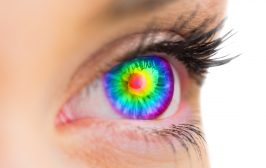-
See the Savings Clearly: Save 20% On LASIK , Find More
*Must mention this promotion and be treated in April of 2024 to qualify. 20% off standard price of Wavelight procedure. Cannot be combined with any other offers.
Common Vision Problems & How They Are Corrected
More than 11 million Americans have vision problems due to refractive errors. Fortunately, the majority of these issues can be addressed with prescription eyewear or laser vision correction.
Types of Refractive Errors & When They Occur
The most common refractive errors are nearsightedness, farsightedness and astigmatism. All of these are caused by light not bending — or refracting — correctly as it hits the eye. Nearsighted individuals have difficulty seeing objects far away. Farsighted individuals have difficulty seeing objects up close. Those with astigmatism have football-shaped eyes, which causes objects to appear blurry.
Most children have clear distance and up-close vision. Starting in adolescence, some develop a refractive error and need corrective lenses. The prescription for these lenses may change often from adolescence into early adulthood. In adulthood the prescription stabilizes and varies little thereafter.
As many people enter middle age, they develop a condition called presbyopia. This is caused by the natural lens of the eye becoming inflexible, which affects the ability to see up close.
Types of Vision Correction
Glasses are the oldest method of refractive vision correction and have been around for hundreds of years. Contact lenses have been available since the 1950s. Both glasses and contacts change how light focuses on the retina, which corrects the refractive error and improves vision. Reading glasses help those with presbyopia see up close.
Since the 1990s, a laser vision correction method called LASIK (laser assisted in situ keratomileusis) has been available as a third option to correct refractive vision problems. LASIK reduces or eliminates refractive errors by changing the structure of the cornea, which is located on the front surface of the eye. This restores visual function.
LASIK is a two-step process. First, the doctor uses a laser to create a flap in the eye’s cornea to preserve the skin of the eye called the epithelium. In the second step, the doctor uses another laser to etch an individual’s own corrective lens prescription on the cornea below the flap. The flap is then put back in place.
No stitches are used in LASIK, and healing is fast for the majority of patients. In fact, many are able to return to work the next day. Numbing drops are used, so patients experience very little discomfort. While side effects and complications may occur, they are rare and usually temporary.
Patients with presbyopia may benefit from monovision LASIK. Monovision corrects one eye’s distance refractive error, while the other eye is left mildly nearsighted for near vision.
Symptoms Versus Cause
Glasses and contact lenses only improve the symptoms of refractive errors. LASIK reshapes the surface of the eye, therefore addressing the structural cause of blurry vision due to refractive errors. This allows the eye to focus without the use of glasses or contacts. LASIK addresses the cause of refractive errors, not just the symptoms.
Each person’s eyes are different. Always consult with a trusted, experienced ophthalmologist to determine which vision correction solution is best for you.
YOU MIGHT ALSO LIKE...
VISION CENTERS NEAR ME
Enter your zip code, city, or a doctor name below to find a vision center.
Find out if LASIK is right for you
Congratulations!
Your vision issues can most likely be corrected with a LASIK procedure. Schedule a free consultation today.
Answer 5 simple questions to see if you are a candidate
What is your age group?
Do you wear...
With corrective lenses, do you have...
Have you ever been told that you have astigmatism?
Have you ever been told that you have dry eyes?
Request an Information Kit
Learn about your surgeon, the latest advanced technology, procedures, options and benefits, financing options, and what to expect from your LASIKPlus experience.









